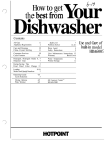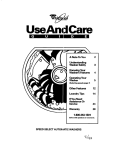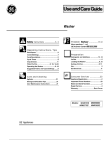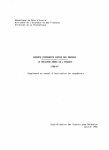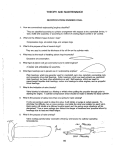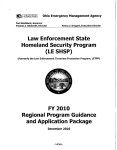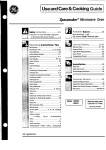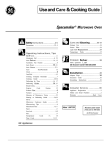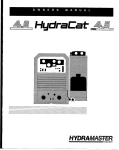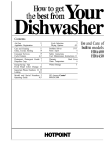Download GE GSD400T User's Manual
Transcript
Dishwasher
m
.:
,❑.- . -,
●
Safe~ instructions .........................3
Problem Solver .......................l2-l4
More questions ?...call
GE Answer Centerm 80~626.2000
Operating Instructions, Tips
ApplianceRegistration..................................2
China, Crystal, Sterling . . . . . . . . . . . . . . . . . . . . . . . . . . . . . . . 10
Cycle Description............................................5
DetergentGuide.............................................7
DispenserCups...............................................7
Drying Options ................................................4
Energy-Saving Tips.........................................2
Features ........................................................4,
5
Loading .........................................................8,
9
Operating instructions..............................4, 5
Rinse Agent......................................................6
Water Temperature . . . . . . . . . . . . . . . . . . . . . . . . . ...............6
:’,”<,
Care and Cleaning
Air Gap . . . . . . . . . . . . . . . . . . . . . . . . . . . . . . . . . . . . . . . . . . . . . . . . . . . . . . . . . . . . 11
Winter Storage . . . . . . . . . . . . . . . . . . . . . . . . . . . . . . . . . . . . . . . . . . . . . 11
❑
@
Consumer Services
...................15
Model and Serial Numbers ..........................2
Repair Service .................................................2
Warranty........................................BackCover
Model GSD400 I
GE Appliances
HELP US HELP YOU...
Before using your
dishwasher, read this
guide carefully.
It is intended to help you
operate and maintain your new
dishwasher properly.
Keep it handy for answers to
your questions.
If you don’t understand something
or need more help, write (include
your phone number):
Consumer Affairs
GE Appliances
Appliance Park
Louisville, KY 40225
If you received
a damaged dishwasher...
Write down the model
and serial numbers.
Immediately contact the dealer
(or builder) that sold you the
dishwasher.
You’ll find them on a label
fastened to the tub wall just
inside the dishwasher door.
These numbers are also on the
Consumer Product Ownership
Registration Card that came
with your dishwasher. Before
sending in this card, please write
these numbers here:
Save time and money.
Before you request
service . . .
Check the Problem Solver in the
back of this guide. It lists causes
of minor operating problems that
you can correct yourself.
Model Number
Serial Number
Use these numbers in any
correspondence or service
calls concerning your dishwasher.
W YOU NEED SERVICE...
To obtain service, see the Consumer
Services page in the back of this guide.
We’re proud of our service and want you to be
pleased. If for some reason you are not happy with
the service you receive, here are three steps to follow
for further help.
FIRST, contact the people who serviced your
appliance. Explain why you are not pleased. In
most cases, this will solve the problem.
NEXT, if you are still not pleased, write all
the details—including your phone number—to:
Manager, Consumer Relations
GE Appliance
Appliance Park
Louisville, KY 40225
FINALLY, if your problem is still not resolved, write:
Major Appliance Consumer Action Panel
20 North Wacker Drive
Chicago, IL 60606
ENERGY-SAV~G T~S
●
Operate dishwasher only when it’s full. Let the
dishes accumulate in dishwasher. Be sure to latch
the door when waiting for a full load. This helps
keep soils moist, easier to remove.
2
●
If you don’t need your dishes right away, use your
NO HEAT DRY option (energy saver drying
feature) that turns the drying heater off
automatically. Dishes dry naturally over a longer
period such as overnight.
A
WARN~G-When using this
apptiance, always exercise basic
safety precautions, including the
following:
. Use thk appHmcc ody for its ktended
purpose, as you til tid deseribed in
this Use and Care Guide.
This dishwasher must be properly
installed and located in accordance
‘Q-\4:”
b ,.
y
+
with
the bstdlation hstructions
.+.
before it is used. If you did not
receive an hstaUation Instructions sheet with
your dishwasher, you can obtain one by calling,
toll free, the GE Answer Centefl 800,626,2000.
—This app~anc~ must be connected to a
groundd rneti, permanent wiring system;
or an equipment-grounding conductor must
be run with the circuit conductors and connected
to the equipment-grounding terminal or lead of
the appliance.
—Connect to a properly rated, protected and sized
power-supply circuit to avoid electrical overload.
●
●
..
=
●
●
●
Do not store or use combustible
materhds, gasotine or other
flammable vapors and liquids
in the vicinity of this or any other appliance.
Use only powder or liquid detergents or wetting
agents recommended for use in a dishwasher.
Do not wash plastic items unless marked
“dishwasher safe” or the equivalent. For
plastic items not so marked, check the
manufacturer’s recommendations.
Load light plastic items so they will not
become dislodged and drop to the bottom
of the dishwasher—the might come into
contact with the Cdrodx heating element
and be damaged.
To tinifize the possibility of injury.
●
When loading items to be washed:
A. Locate sharp items so that they are
not likely to damage the door seal, and
B. Load sharp knives with the handles
up to reduce the risk of cut-type injuries.
c Do not tamper with controls.
●
●
●
Do not touch the Cdrod” heating element
during or immediately after use.
Do not operate your dishwasher unless dl
enclosure panels are properly in place.
Do not abuse, sit on, or stand on the
door or dish rack of the dishwasher.
Close supervision is necessary if this appliance
is used by or near children. Do not allow children
to play inside, on or with this appliance or any
discarded appliance. Dispose of discarded
appliances and shipping or packing material
properly. Before discarding a dishwasher,
remove the door of the washing compliment.
Keep dl washing detergents and wetting agents
out of the reach of children, preferably in a locked
cabinet. Observe all warnings on container labels
to avoid personal injury.
To minimize the possibility of
“
electric shock, disconnect this
appliance from the power supply
<efore attempting any maintenance. NOTE:
Turning the control did to the OFF position
does not disconnect the appliance from the
power supply, We recommend having a qualified
technician service your appliance.
●
●
$%
●
A
WARN~G-~DROGEN GAS
is produced by the chemical action
within your water heater. It can
accumulate in the water heater andor
water pipes if hot water has not been used for a
period of two weeks or longer. HYDROGEN GAS
IS EXPLOSIVE. To prevent the possibility of
damage or injury, if you have not used hot water
for two weeks or more, or moved into a residence
in which the hot water system may not have been
used for some time, turn on all hot water faucets
and allow them to run for several minutes before
using any electrical appliance which is connected
to the hot water system. This will allow any
hydrogen gas to escape. Also, since the gas is
flammable, do not smoke or use an open flame
or appliance during this process.
SAVE THESE
INSTRUCTIONS
3
HOW TO OPERATE YOUR DIS~ASHER
I\
I
STEP 1. Load your dishwasher with dishes, silverware,
pots, pans, bowls, etc., according to the Loading section.
STEP 2. Add detergent to the detergent dispenser.
Make sure the Cycle Indicator Dial is at 0~ position
before adding detergent. (See Detergent Guide).
Use rinse aid agent to help prevent spotting. Occasionally
check to insure that rinse agent container is at least hdf
full. (See How to Use a Rinse Agent section).
STEP 3. Select drying option.
HEATED DRY. Turns the
drying heater on for fast drying.
NO HEAT DRY. Turns the
drying heater off to save energy.
The dishes will dry naturally over
a longer period such as overnight.
If you need your dishes sooner, open the dishwasher
door after the cycle is complete to reduce the natural
drying time.
Use of this option reduces the electrical energy used
by this model approximately 10%.
4
I
STEP 4. Select the wash cycle and start the dishwasher.
(See Cycle Selection Hint~.
If your dishwasher drains into a food waste disposer,
operate the disposer until it is empty before starting
the dishwasher.
To obtain the benefits of a complete cycle,
be careful that you do not turn the dial any
farther than necessary to start the dishwasher.
● For NORMAL WASH cycle:
I
0: ;AM
a Latch the door.
t
b. Slowly turn Cycle Indicator
DRVING
Dial to START position to
start the cycle. You will hear
@WASHING
the motor start. There is a time
delay between the start-up
and the water fill so you will
not hear any wash action right away.
c. Latch door to stirt the cycle.
Cycle Description
It is important to follow the Loading instructions.
● NO~AL WASH—For items such as pots, pans, cookware,
dishes and glasses with heavy soil. Everyday dishes may be included.
What Happens in Each Cycle
During the drying period:
—The motor stops.
—Water vapor comes through the
vent by the door latch during drying
and when water is being pumped out.
You’11 hear occasional clicking sounds:
—Soft food disposer shredding action.
—Drain valve opening to pump water out.
—Timer control as cycle progresses.
—Detergent cup opening.
●
●
Wash Cycles
NORMAL WASH
Water Use
Gallons
(approx.)
Wash Cycle
Time
Minutes
(approx.)
I 1.4
g6*
Cycle Sequence
mmmmmmm
Drying Options:
HEATED DRY. *Time will increase when Heated Drying is selected.
NO HEAT DRY. Drying heater is turned off. Dishes dry naturally.
5
Good Dishwashing Stirti with HOT Water
To get your dishes clean and dry, you need hot water. To help you get water of the proper
temperature, your dishwasher automatically heats the water in the wash cycle. For good washing
and drying, the entering water must be at 120°F. To prevent dish damage, the inlet water should not exceed 150°F.
How to Test Water Temperature
Higher water temperature is needed to dissolve grease
and activate powder detergents. Check water temperature
with a candy or meat thermometer. Turn on the hot water
faucet nearest dishwasher. Put the thermometer in a glass
and let the water run continuously into the glass until the
temperature stops rising. If the water temperature is
below 120°F., adjust your water heater.
Helpful hints: If outside temperatures are unusually low,
or if your water travels a long distance from water heater
to dishwasher, you may need to set your water heater’s
thermostat up. If you have not used hot water for some
time, the water in the pipes will be cold. Turn on the hot
water faucet at sink and allow it to run until water is hot.
Then start dishwasher. If you’ve recently done laundry
or run hot water for showers, give your water heater time
to recover before operating the dishwasher.
To improve washability if water is less than 120°F.
and you cannot adjust your water heater: Select a
longer cycle and fill both detergent cups at least half-full
with detergent.
How to Use a Rinse Agent
The rinse agent makes water flow off dishes quicker
than usual. This lessens water spotting and makes
drying faster, too.
For best dishwashing performance, use of a rinse
agent such as JET-DRY brand is recommended.
Rinse agents come in either liquid or solid form.
Your dishwasher uses the liquid form.
How to fill the rinse agent dispenser. ‘~s’”m
Unscrew the cap. Add fiq,uid ri;se agent
until it just reaches the bottom of the lip
#
;Y
inside the dispenser opening. Replace
FULL
the cap. The dispenser automatically
releas;s the rinse agent into the fin;l rinse water.
If you accidentally spill: Wipe up the rinse
agent with a damp cloth. Don’t leave the spill in the
dishwasher. It can keep your detergent from working.
If you can’t find any rinse agent, write:
BENCKISER CONSUMER PRODUCTS, INC.
(“JET-DRY”)
Corporate Centre 1
55 Federal Road
P.O. Box 1991
Danbury, CT 06813-1991
How to Choose and Use the Right Detergent
First, use only powder or liquid detergent
specifically made for use in dishwashers.
Other types will cause oversudsing.
Second, check the phosphate content. Phosphate
helps prevent hard-water materials from forming
spots or film on your dishes. If your water is hard
(7 grains or more), your detergent has to work
harder. Detergents with a higher phosphate level
will probably work better. If the phosphate content
is low (8.790 or less), you’ll have to use extra
detergent with hard water.
Your water department can tell you how hard your
water is. So can your county extension agent or your
6
area’s water softener company. Just call and ask
them how many “grains” of hardness there are
in your water.
How much detergent should you use? That
depends. Is your water “hard” or “soft”? With
hard water, you need extra detergent to get dishes
clean. With soft water, you need less detergent.
Too much detergent with soft water not only wastes
money, it can be harmful. It can cause a permanent
cloudiness of glassware, called “etching.” An outside
layer of glass is etched away! Of course, this takes
some time. But why take a chance when it’s easy
to find out the hardness of your water.
Keep your detergent fresh and
dry. Under the sink isn’t a good
place to store detergent because
there is too mucb moisture. Don’t
put powder detergent into the
dispenser until you’re ready to wash
dishes. (It won’t be fresh OR dry).
If your powder detergent gets old
or lumpy, throw it away. Old
detergent often won’t dissolve.
If you use a liquid dishwasher
detergent, these precautions are not
necessary because liquid detergents
don’t “lump” as they age or come
in contact with moisture.
You’ll find two detergent
dispensers on the inside door of
your dishwasher. Two, because
some cycles use two washes.
See “Detergent U.~uge
Guide” belc~w.
i~ure the CYCL
INDICATOR
DIAL ii~ at
OFF
po,~iti(m
b<fc~re
adding
detergent.
Otherwi.ve, the detergent cup
will not clc~,se and l(ltch pr(~perl~).
NOTE: T() open the detergent cup
clfier it has been clc).~ed, utdatch the
-
GRASP HANDLE,
{Jperi p(~.~ition
ROTATE AND
bef[~re r(~t(~ting
the Cycle Indicclt(~r CLOSE TIGHTLY
Dial. “Thi,~ will help
reduce the (lmount (~j”detergent and
rin.ye (lid agent .~pillage intc~ the tub.
Detergent Usage Guide (powder or liquid)
SOFT WATER
(0-3 grains hardness)
CYCLE
NORMAL WASH
I
Main Cup
Half Full
Open Cup
~ Half Full
I
MEDIUM WATER
(3-7 grains)
I
Main Cup
I
Open Cup
Completely ~ Half Full
Full
I
*12 grains and up is extremely hard wtiter. A water soltener is recommended. Without it.
lime can build up in the water valve. The water v:dve may stick while open and cause flooding.
HARD WATER
(7- 12 grains*)
I
Main Cup~
I
Open Cup$
Completely ~ Completely
Full
I Full
~: Filled Main Cup holds 3 tablespoons;
Filled Open Cup holds 2 tablespoons.
How to Prepare the Dishes for Washing
If this is your first dishwasher, or if you’re replacing a much older model, you may wonder how
much preparation your dishes need. Actually very little. Prerinsing of normal food soils is not necessary.
With common sense and a little practice you’ll soon know what foods to remove. Here are some guidelines:
1. Scrape off bones, seeds, skins, toothpicks and
3. Try to remove food scraps and place dishes in
dishwasher before soil has a chance to dry and
other hard solids. It is also best to remove hardshelled vegetables, meat trimmings, leafy
become hard.
vegetables and crusts. Remove excessive
NOTE: The foods mentioned are examples
quantities of oil or grease.
only, Other foods not mentioned may also need
2. Remove large quantities of any food. Your
to be removed from your dishes. You may also
want to consider removing foods such as mustard,
dishwasher has a built-in soft food disposer that
mayonnaise, vinegar, lemon juice and other foods
pulverizes soft food bits and flushes them away.
that can cause discoloration of stainless steel if
It can handle small amounts of soft foods, but
large amounts will be difficult to handle.
allowed to remain on dishes for a long period of time.
7
HOW TO LOAD YOUR DISHWASHER
Thi,~ is (~ r[lnd(~m mixed l(~(ld, the m(~.~t c{~mmc]n type
vc~u will have.
Make sure dishes are properly loaded to insure that
water can reach the soiled surfaces. The wash arm
in the bottom sprays water up. The tower that rises
in the center sends water out over the dishes to wash
the items in the upper rack.
WATCH OUT FOR THIS.
The wash tower rises through the center of the bottom
rack during the wash and rinse portions of the cycle.
Don’t block it or load tall things next to it. Also, be
careful not to let a portion of an item such as a pot or
dish handle extend through the bottom rack. This could
block the wash arm and cause poor washing results.
HOW TO LOAD THE TOP RACK
The top rack is best for glasses, cups and saucers.
Cups and glasses fit best along the sides. This is
the place for dishwasher-safe plastics, too. Make
sure small plastic items are lodged in tightly so
they can’t fall onto the Calrod(’> heating element.
Arrtinge stemware so that they cannot move easily,
Don’t let the glasses touch each other.
8
This rack is ideal for dishwasher-safe plastics. When
loading, place plastic items along the back and be sure
that ea;h-plastic tumbler is secured over two fingers
This will prevent dislodging; tumbler will not fall
through rack onto the Calrod@ heating element.
Pots, pans, casseroles, salad bowls, mixing bowls and
lids must be loaded in the bottom rack, facing down.
Load platters, pots, pans and bowls along the sides, in
corners or in the back. All large items, such as pitchers,
salad bowls and mixing bowls, should be washed in the
lower rack.
Fit plates and saucers between the pins. Place items
so that water and detergent from wash arm can reach
soiled surfaces.
Heavily soiled pots, pans and casseroles MUST be loaded
in the bottom rack, facing down. Prop broiler pans and
racks along the edge.
Put flatware in the removable basket with handles up
to protect your hands. Mix knives, forks and spoons
so they can’t nest together. Distribute evenly. Small
plastic items, such as measuring spoons and lids from
small containers are not recommended for automatic
dishwashing. If placed in the dishwasher, they should go
in the bottom of silverware basket with silverware on top.
Precaution!
Take out anything that may fall or extend through the
bottom of the basket
9
WHAT YOU CAN USUALLY WASH SAFELY
~ YOUR DIS~ASHER.
Material
Usually
Safe
Atuminum
YES
Chinti
Stoneware
YES
Crystal
YES
Non4ishwashe]
items—such
as electronic
air cIeaner
filters, furnace
filters, paint
brushes, etc.
Glass
Iron
NO
Plastics
YES
NO
NO
YES
Stainless steel
YES
Sterling Silver
and Silver plate
YES
Non-stick
coatings
Tin
Wood
YES
NO
NO
Exceptions (not safe)
Special Instructions
Some colored anodized
aluminum can fade.
Antique, metal-trimmed,
hand-ptinted or over-the-glaze
patterns fade. Gold leaf
will discolor.
Antique, metal-trimmed or
hand-painted patterns fade.
Gold leaf will discolor.
Some darkening or spotting possibie. Remove by
scouring with soap-filled steel wool pads.
If in doubt, check with the manufacturer. Or test wash
one piece daily for at least a month. Compare with the
rest of the set.
Load securely to prevent movement. Check your
manufacturer’s instructions for your crystal.
Do not wash in dishwasher. Damage to dishwasher
and discoloration or staining of dishwasher may result.
Milk glass may yellow.
Iron will rust.
Pewter tarnishes.
Don’t put in same silverware
basket with stainless steel.
Contact between metals can
damage silver.
Don’t wash copper utensils in
the same load, Silver may get a
brown film.
Adhesive used to attach some
hollow-handle knives can loosen.
If it doesn’t say DISHWASHER S~, test one piece in
the top rack before dishwashing an entire set.
Rinse if not washing immediately. Salty or acid foods
can stain if left on.
Rinse if not washing immediately. Salty or acid foods can
stain if left on. Dry detergent can cause difficult-to-remove
black spots. Place in back section of silverwwe basket to avoid
exposure to detergent from the detergent cup.
After washing, wipe the non-stick coating area with
vegetable oil to keep it from losing its non-stick quality.
Tin can rust.
Wood can warp, crack or lose
its finish with any type of washing.
Forget a dish? Here’s when you can add it.
Add dishes anv. time BEFORE the main detergent wash portion of the cycle. However,
opening the door during any cycle lessens cle~ning pow~r. So try to load everything at the beginning.
Here’s how to add a forgotten dish:
3. Add dishes you’ve forgotten.
1. Push the door latch to the left. Washing will stop.
4. Close the door and push the latch to the far right.
2. Wait a few seconds until the water calms. Then
When the door is locked, washing will continue.
open the door. WARNING: Hot vapor may rise
from opened door.
10
USER MAINTENANCE INSTRUCTIONS
Clean the control panel with a lightly dampened
cloth. Dry thoroughly. Do not use abrasives or
sharp objects on the panel. They can damage it.
Clean the outside with a good appliance polish
wax. The outside cabinet finish is durable, but it
can scratch. So use no scouring pads, or harsh or
gritty cleaners.
Appliance Polish Wax & Cleaner (Cat. No.
WR97X02 16) is available from GE Appliance
Parts Marts.
The inside usually takes care of itself. If it should
ever need cleaning, use a mild cleansing powder.
Scouring pads and harsh cleaners can mar the finish,
Not Using Your Dishwasher in Winter? Protect Against Freezing.
If your dishwasher is left in an
Drain water from the inlet line
PUMP COVER SCREWS
I
I
and water valve. (Use a pan to
unheated place during the winter,
●
ask a service technician to:
● Cut off electrical power to the
dishwasher. Remove fuses or trip
circuit breaker.
● Turn off the water supply.
c Disconnect the water inlet 1 ine
from the water valve.
catch the water.)
● Reconnect the water inlet line to
the water valve.
● Remove the plastic pump cover
in the tub bottom and use a
sponge to soak up water in
the rubber boot.
Built-in Dishwashers Often Use an Air Gap. Keep It Clean.
An air gap is a plumbing device.
It protects your dishwasher against
water backing up into it if a drain
clogs. The air gap is not a part of
the dishwasher. And you may not
even have one. Not all plumbing
codes require air gaps.
Check the air gap any time your
dishwasher isn’t draining well.
If you have an air gap, check it at
least once a month. IT IS NOT
PART OF YOUR DISHWASHER.
IT IS NOT COVERED IN YOUR
WARRANTY.
The air gap is easy to clean.
With most types, first turn off the
dishwasher, then lift off the chrome
cover. Then unscrew the plastic cap
and check for any buildup of grit.
A toothpick makes cleaning easy.
11
QUESTIONS?
USE THIS PROBLEM SOLVER
PROBLEM
POSSIBLE CAUSE
DISHWASHER
WON’T RUN
A fise in your home may be blown, or the circuit breaker tripped. Replace fuse or
reset circuit breaker. Remove any other appliances from the circuit.
UNUSUAL NOISE
Utensils may not be secure on rack pins, or something small may have dropped from
the rack. Water is causing utensils to rattle. Make sure everything is securely placed
in dishwasher.
DISHES DON’T DRY
Make sure inlet water temperamre is correct. (See How to Test Water Temperature
section).
Unload the bottom rack frost. Water from dishes in the top rack maybe spilling into
the bottom rack.
Check fur improper loading. Dishes shouldn’t nest together. Avoid overloading.
Check the rinse agent dispenser to see that it’s not empty.
UNCLEAN DIS~S
AND FLATWARE
Check inlet water temperature. It should be at least 120°F. (To test, see How to Test
Water Temperature section).
Water pressure may be temporarily low. h on a faucet. Is water coming out slower
than usual? If so, wait until pressure is normal before using your dishwasher.
Plugged air gap. (See Care and Cleaning section).
hproper rack loading. (See Loading section).
DETERGENT LE~
~ DISPENSER CUPS
Water may not be reaching the detergent cups. Move dishes that maybe blocking
,
detergent CUP.
me dispenser cover may not be opening or maybe blocks by improperly loaded
items. If you used a powder detergent, open the cup and remove any caked-on
detergent. If the cup still doesn’t open automatically, cdl for service.
De@rgent maybe old. If the powder detefgent is hard or caked in the box, throw it
away. The detergent may not be working well. Try another brand.
DE~RGENT CUP
LID WON’T LATCH
-R ADD~G
DETERGENT
Cycle Indicator Di& must be O= for cup lid to close and latch properly. If you
unlatch the door and open it to dry your dishes, the Cycle Indicator Did does
nLLOW OR
BROWN ~M
Tea or coffee can stain cups. Remove the stin by hand, using a solution of 1/2 cup
bleach and 3 cups warm water.
An overall yellow or brown film on dishes or glassware can be caused by iron
deposits in water. A special filter in the water supply line is the only way to correct
this problem. Your water softener company can tell you about the filter.
Yellow film on sterling silver results when you wash copper utensils in the same load.
Silver polish will usually remove this stain.
12
not advance by itself.
PROBLEM
POSSIBLE CAUSE
SPOTS AND
FILMING ON
GLASSES AND
FLATWARE
Spotting can be caused by dl these things:
Extremely hard water. (See How to Choose and Use Detergent section).
● Low inlet water temperature. (See How to Test Water Temperature section).
●
Overloading the dishwasher.
● Improper loading. (See Loading section).
● Old or damp powder detergent.
● Phosphate level in detergent too low. (See How to Choose and Use
Detergent section).
● Rinse agent dispenser empty. (See How to Use a Rinse Agent section).
● Too little detergent. (See How to Choose and Use Detergent section).
Local water conditions md personal preferences vary. Try wverd brands of
detergents to find one that gives the best results for you. A liquid dishwasher
detergent may help reduce filming.
●
To remove stubborn spo~ and ~m from g~sware:
1. Remove dl metal utensils from the dishwasher.
2. Do not add detergent.
3. Start the dishwasher and allow to run for 18 to 22 minutes. The dishwasher will
now be in the main wash.
4. Then open the door and pour 2 cups (500 d) of white vinegar into the bottom of
the dishwasher.
5. Close the door and allow to complete the cycle.
If tinegar tinse doesn’t work: Repeat as above, except use 1/4 cup (60 d) of citric
acid crystals instead of vinegar. (Most drugstores carry citric acid crystals. If yours
doesn’t, call GE Factory Service).
Using a vinegar or citric acid crystal rinse more than twice a month? Consider a home
water softener.
CLOUD~ESS ON
GLASSWAW
If vinegar or citric acid crystal rinse doesn’t work, the cloudiness is “etching.”
The film cannot be removed.
It can be prevented: Use less detergent if you have SOR water. Wash glassware in
the shortest cycle that will get them clean.
Water temperature entering dishwasher exceeds 150°F.
CHIPPING OF CHINA
Rough handling can cause chipping. Load with care. Make sure glassware and china
are secure and can’t jar Ioose. (See Loading section). Make sure tti glasses and
stemware will clear the top of the tub when you push the rack into the dishwasher.
Always use the top rack for delicate items.
(continued next page)
13
—
T~ PROBLEM SOL~R
(continued)
PROBLEM
POSSIBLE CAUSE
BLACK OR GRAY
MARKS ON DISHES
Muminum utensils often leave marks when they rub against dishes. Remove marks
with a mild abrasive cleanser.
SMALL AMOUNT OF
WA~R STAND~G
IN ~ BO~OM
OF THE TUB
Water around the outlet on tie tub bottom at the back of the tub is normal. It is clean
water. It’s there to keep the water seal lubricated.
WATER WON’T PUMP
OUT OF THE TUB
If the entire bottom of the tub has water, you may have a drain problem. Clean the
air gap, if you have one. (See Care and Cleaning section).
Check the kitchen sink. Is it draining well? You may need a plumber.
If dishwasher drains into disposer, run disposer to clear. Be sure disposer is not
clogged.
SUDS IN THE TUB
Sudsing detergents are not meant for dishwashers. USE ONLY AUTOMATIC
DISHWASHER DE~RGENTS TO AVOID SUDSING.
To remove suds from the tub: Open the dishwasher. Let suds evaporate. Add 1
gallon of cold water to the tub. Close and latch the dishwasher. Pump out water by
slowly turning the control dial until a drain period is reached.
Repeat if necessary.
DISHWASHER
LEAKS
Suds can cause unit to oveflow. That’s why it’s so important to use a detergent that’s
designed for automatic dishwashers.
Spilling the rinse agent can cause foam during washing. This can lead to overflowing.
Wipe up accidenti spill of rinse agent with a damp cloth.
MOTOR HUMS
Dishwasher has not been used on a regular basis.
If you do not use your dishwasher often, set it to fill and pump out once every week.
This will help keep the sed moist, and the garbage disposer clear.
STMMNG OF
TUB INTERIOR
Some detergents contain colorant (pigment or dyes) that will discolor the tub
interior with extended use. Check the detergent cup for signs of any discoloration.
If cup is discolored, change to detergent without any colorant.
If you need more help.. call, toll free:
GE Answer Center@
800.626.2000
consumer information service
Wdll Be There
With the purchase of’your new GE appliance, receive the assurance that if you ever need
information or assistance from CIE, we’ll be there. All you have to do is call—toll-free!
In-Home Repair Service
80WE<ARES(80M32-273~
A (;E consumer service prof’ession:d” will provide expert repiiir service, scbeclulcd :it ;~ time tb;~(’s convenient fi)l- you, M:irry (;E1 (;onsurner Service companyoper:i(ed loc:~tions” off’er you service to(liiy or lonlorrow, or ;it youI- corrvenicncc
(7:()() ~i.nl. to 7:()() p.m. wcekdi~ys, !):()() ii.nl. [() 2:()() p.m. S:Iturd~tys). Our fActorytr;lined (echniciilns krlow yoLlr iippli:ulre inside ilrld OLI[-S() rrlost rep;~irs cilrl he
handled irl,just one visil.
GEAnswer Center@
80~6262000
M~}l~te\,~rvo~lr
qLlestion :~bout ;~rry (JE Illiijor-;ti>pli:irl(c, (;E1 Answer (;crll.er@
,
infi)rrnzitiorr service is :ivail:ible to help. Y;)LIr (:ill-iind YOUI qnes[iorl- will be
~mswer-ed prorrlp{ly ;md courteously.” And you c;tn citll >lrly [ irne. (;E Answer
(;enter@ service is open 24 hour-s ~1 day, 7 diiys ~1 week.
kr Customers With Special Needs...
80~62E2000
s,m,o. a.A
,,, .”.,..”.,...,.!.,...,.” .“-.
. . . . . . . . . . . . . . . . . . . . . . . ~.,
r,.,
Upon request, (;1; will provide
l}rilille controls” fi)r;1 v;lrie[y of’(;~;
(;orls[rnlers with imp:~ired hearing or speech who have
:ircess to a TDD or a conventional” teletypewriter may
;ippli:ulces, :uld :i br”octrurc” to
;~ssist in pl:lnn in, q ii b;uriet’-f’ree
kitchen fi)r persons wi[h Iitni{ed
mobility. ‘I() ob[:iirl these items,
free of’ch~~rge, c:ill 800.( i2(j.2000.
czdl 800-TDD-(”;EA[;”
1 ion or service.
(800-833-4322; to ’x:eques[ infor:ma-
Service Contracts
80@62&2224
You citn have the secL]re f’eeling Lllat (;E (;{)rlsllrl]c>rSct-\ic:c; will still be [her-e
ilf’tet your- w:lrrant.y expires. I’urcbt{se a (;E contract while your w~lrr:ulty is still
in efl’cc( and you’ll receive ii subs[;mti;d discount. With a rnultiplc-ye;tr corrtr;~ct,
you’re ;issurcd of ’filturc service ;{t (od;iy’s pr-ices.
Parts andAccessories
80@626-2002
Individuds qualified to service their ow appliances
c:in b:lve needed p:u-ls or accessories sent dit-c’c{ Iy [()
tllcir- Ilon]c.. ‘I-bc (;E1 p~u(s sys(em pl-ovidcs iu:cess (() over
47,()()() p:uts... imd ;dl (.;E (;enuine Ilenew;il I’:uls are
fully warranted. VISA, Master(larci ~irrd r)iscovcr c:trds
arc accepted.
User maintenance instructions contained in this booMet
cover procedures intended to be performed by any user.
Other servicing gener~y shotid be referred to qu~fied
service personnel. Caution must be exercised, since
improper servicing may cause unsafe operation.
YOUR GE AUTOMATIC DISHWASHER
WARRANTY
Save proof of onglnal purchase date such as your sales slip or cancelled check to establlsh warranty period
WHAT IS COVERED
“7
ULL ONE-YEAR WARRANTY
For one year from date of original
purchase, we will provide, free of
charge, parts and service labor in
your home to repair or replace any
; pafi of the dishwasher that fails
%ecause of a manufacturing defect.
<,;.$,
~~
\%or ten years from date of original
purchase, we will provide, free of
charge, parts and service labor in
your home to repair or replace the
tub or door liner if it fails to contain
water because of a manufacturing
defect such as cracking, chipping,
peeling or rusting.
WHAT IS NOT COVERED
Sewice trips to your home to teach
you how to use the product.
Read your Use and Care material.
If you then have any questions
about operating the product, please
contact your dealer or our
Consumer Affairs office at the
address below, or call, toll free:
GE Answer Center@
800.626.2000
consumer information service
● Improper installation.
If you have an installation problem,
contact your dealer or installer.
You are responsible for providing
adequate electrical, plumbing and
other connecting facilities.
●
This warranty is extended to
the original purchaser and any
succeeding owner for products
purchased for ordinary home use
in the 48 mainland states, Hawaii
and Washington, D.C. In Alaska the
warranty is the same except that it
is LIMITED because you must pay
to ship the product to the sewice
shop or for the service technician’s
travel costs to your home.
All warranty service will be
provided by our Factory Service
Centers or by our authorized
Customer Care(’) servicers during
normal working hours.
Should your appliance need
sewice, during warranty period or
beyond, call 800-GE-CARES
(800-432-2737).
Replacement of house fuses or
resetting of circuit breakers.
● Cleaning or sewicing of air gap
device in drain line.
● Failure of the product if it is used
for other than its intended purpose
or used commercially.
● Damage to product caused by
accident, fire, floods or acts of God.
WARRANTOR IS NOT
RESPONSIBLE FOR
CONSEQUENTIAL DAMAGES.
●
Some states do not allow the exclusion or limitation of incidental or consequential damages, so the above limitation or exclusion
may not apply to you. This warranty gives you specific legal rights, and you may also have other rights wh;ch vary from state to state
To know what your legal rights are in your state, consult your local or state consumer affairs office or your state’s Attorney General.
Warrantor: General Electric Company
If further help is needed concerning this warranty, write:
Manager—Consumer Affairs, GE Appliances, Louisville, KY 40225
This book is printed on recyc/ed paper.
Pad No. 165 D3080P278
Pub No. 49-5588
11-92
CG
GSD40(

















